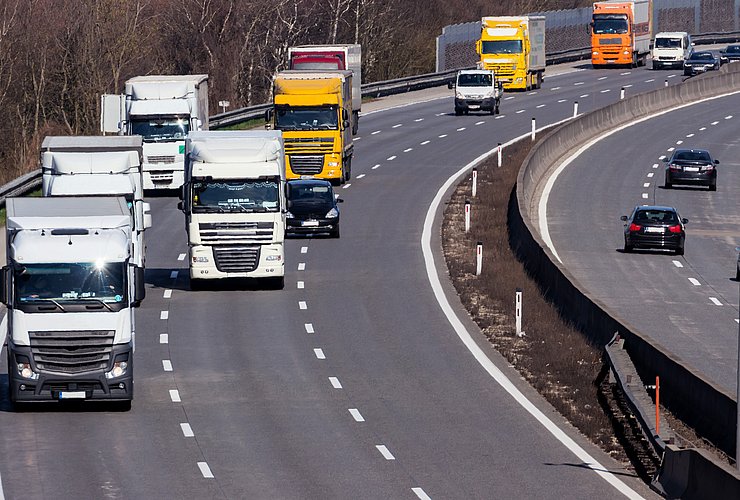Vehicle prohibitions in accordance with the IG-L
Vehicle prohibitions and speed restriction in accordance with the Austrian Ambient Air Quality Act (IG-L)
General information
The Austrian Ambient Air Quality Act (IG-L), which in particular transposes EU directives relating to air pollution control, pursues important objectives such as sustained protection against harmful and unacceptable air pollutants and preventive reductions in the emission of air pollutants. Pollution from air pollutants is permanently monitored in Tyrol. Levels of nitrogen dioxide (NO2) which exceed the permissible limits have been recorded in the A 12 Inntal motorway and the A 13 Brenner motorway areas in particular for many years.Investigations have indicated that a major contributor to these excessive values is motorway traffic. In 2012, heavy goods traffic and private vehicles accounted for almost 40% of traffic-related NOx emissions at the Vomp/Raststätte A 12 measurement point. Delivery vans accounted for some 20% of emissions, while the rest could be attributed to buses and motorcycles. In view of this, there is a need for the introduction of traffic-related measures in particular in order to achieve national and EU-directed air quality targets. A number of traffic restrictions have therefore been enacted (IG-L - Vehicle Prohibitions, IG-L - Speed Restriction).
Vehicle prohibitions in accordance with the IG-L
As heavy traffic is one of the main causes of NO2 pollution in Tyrolean hotspots, as explained, the Head of the Provincial Government has enacted a number of vehicle prohibitions. A map of the vehicle prohibitions can be found at the following link:
The traffic prohibitions in detail:
Sector vehicle prohibition (Regulation of the Head of the Provincial Government dated 18 May 2016, LGBl. no. 44/2016, as amended by regulation LGBI. no. 115/2016 and regulation LGBI. no. 48/2023):
Which journeys will be prohibited?
The transport of certain goods by heavy-duty vehicles is prohibited on a section of the A 12 Inntal motorway (sector vehicle prohibition).
The following types of goods are affected by the sector vehicle prohibition:
1. All waste currently included on the European Waste List (in accordance with the Commission Decision on a waste list, 2000/532/EC, as last modified by Commission Decision 2014/955/EU)
2. Stone/rock, soils and excavated material
3. Round timber/logs and cork
4. Vehicles in the upper and lower groups L1e, L2e, L3e, L4e, L5e, L6e, L7e, M1, M2 and N1 within the sense of Section 3, para. 1 of the Austrian Motor Vehicles Act 1967
5. Non-ferrous iron ores and iron ores
6. Steel, excluding reinforcing and construction steel for supply to construction sites
7. Marble and travertine
8. Tiles (ceramic) and with effect from 1 January 2020:
9. Paper and cardboard
10. Liquid mineral-oil products
11. Cement, lime and plaster
12. Pipes and hollow profiles
13. Grain
The sector vehicle prohibition will apply to the transport of the aforementioned goods by the following vehicles:
- Heavy goods vehicles and articulated vehicles with a maximum authorised mass in excess
of 7.5 t. - Heavy goods vehicles with trailers, where the total of the maximum authorised masses of both vehicles is in excess of 7.5 t.
Where will the sector vehicle prohibition apply?
The sector vehicle prohibition will apply in both directions on the section of the A 12 Inntal motorway between road distance 6.35 (km) in the Langkampfen local authority area and road distance 72.00 (km) in the Ampass local authority area.
Will there be any exceptions to the sector vehicle prohibition?
The sector vehicle prohibition Regulation has provision for the following exceptions:
- Exception für certain Euro classes:
- Since 1 January 2020: Exception for heavy-duty vehicles of Euro class VI (NOx emissions not exceeding 0.4 g/kWh), first registered after 31 August 2018, provided that the vehicle’s membership of Euro class VI is proven by means of vehicle marking in accordance with the IG-L - Emissions Class Marking Regulations and that the initial registration after 31 August 2018 is proven by means of a document carried in the vehicle (e.g. a registration document);
- Exceptions for destination and origin transport:
- Journeys by vehicles where at least the predominant part of the cargo is loaded or unloaded in a defined core zone (origin and destination in the core zone) as well as journeys by vehicles where at least the predominant part of the cargo is loaded and also unloaded in a defined expanded zone (origin and destination in the expanded zone), provided that they also satisfy the following Euro class specifications and that the respective Euro class is also proven by means of vehicle marking in accordance with the IG-L - Emissions Class Marking Regulations:
- Since 1 January 2020: Euro class V and VI (NOx emissions not exceeding 2.0 g/kWh):
- With effect from 1 January 2023: Euro class VI (NOx emissions not exceeding 0.4 g/kWh):
The core zone incorporates the political districts of Imst, Innsbruck (state), Innsbruck (city), Kufstein and Schwaz. The following are within the expanded zone:- a) Austria: the political districts of Kitzbühel, Landeck, Lienz, Reutte and Zell am See
- b) Germany: the districts of Bad Tölz-Wolfratshausen, Garmisch-Partenkirchen, Miesbach, Rosenheim (incl. city) and Traunstein
- c) Italy: the communities of Eisacktal, Pustertal and Wipptal
A map of the core zone and expanded zone (permanent, temporary) can be found at the links listed below.
- Exception for journeys by vehicles with solely electrical drive mechanism or with hydrogen fuel cell technology;
- Exception for certain journeys in forerun and on-carriage traffic;
- Exception for urgent journeys by the Austrian Armed Forces or foreign troops currently stationed in Austria as well as humanitarian/aid transport by recognised aid organisations.
Finally, an application may be made to the regional administrative authorities to be exempted from this vehicle prohibition on a case by case basis. In that case, the authorities shall examine whether or not, in the case in question, the public interest to be established by the applicant outweighs the interest relating to air pollution control.
In addition, the IG-L also has provision for exceptions in Section 16, para 2.
i.e. for instance vehicles powered by a monovalent methane gas engine (natural gas vehicles NGV), vehicles exclusively powered by an electric engine and also plug-in hybrid electric vehicles (PHEV) with a minimum range of 50 km when powered only by the electric engine, are generally exempt.
Further details may be obtained from the following documents:
- Consolidated version of the sector vehicle prohibition Regulation
- Explanations on the individual provisions of the Regulation
- Explanations on the regulation LGBL. no. 44/2016
- Explanations on the modification by regulation LGBL. no. 81/2019
- Explanations on the modification by regulation LGBL. no. 133/2020
- Explanations on the modification by regulation LGBL. no. 178/2021
- Explanations on the modification by regulation LGBL. no. 141/2021
- Map of the core and expanded zone (permanent temporary)
- Map of the area subject to the vehicle prohibition
Overnight vehicle prohibition for heavy-duty vehicles (Regulation of the Head of the Provincial Government dated 27 October 2010, LGBl. no. 64/2010, as last modified by Regulation LGBl. no. 141/2021):
Which journeys will be prohibited?
On a section of the A 12 Inntal motorway, journeys by certain heavy-duty vehicles will be prohibited during night hours.
The vehicle prohibition will be in force during the following hours:
- 1 May to 31 October: 10 pm to 5 am, Sundays and public holidays 11 pm to 5 am.
- 1 November to 30 April: 8 pm to 5 am, Sundays and public holidays 11 pm to 5 am.
The following vehicles will be affected by the IG-L - overnight prohibition:
- Heavy goods vehicles, articulated vehicles and self-propelled machines with a maximum authorised mass in excess of 7.5 t.
- Heavy goods vehicles with trailers and self-propelled machines with trailers, where the total of the maximum authorised masses of both vehicles is in excess of 7.5 t.
Where will the IG-L - overnight vehicle prohibition apply?
The IG-L overnight vehicle prohibition will apply in both directions on the section of the A 12 Inntal motorway between road distance 6.35 (km) in the Langkampfen local authority area and road distance 90.00 (km) in the Zirl local authority area.
Will there be exceptions to the IG-L - overnight prohibition?
The Regulation has provision for exceptions for:
- Since 1 January 2021, an exemption will be in place for journeys by vehicles in Euro class VI (NOx emissions no more than 0.4 g/kWh) provided that this is demonstrated by appropriate identification of the vehicle in accordance with the IG-L – Emissions Class Marking Regulation, BGBI. II no. 120/2012, as most recently amended by Regulation BGBl. II no. 272/2014 and
- that at least the predominant part of the cargo is loaded or unloaded in the defined core zone (source or destination in the core zone);
- or at least the predominant part of the cargo is loaded and also unloaded in the defined expanded zone (source and destination in the expanded zone)
- or where only the section of the A12 Inntal motorway between road kilometre 72.00 in the district of Ampass and road kilometre 90.00 in the district of Zirl is used for the purpose of goods transport.
- A graphic of the core zone and extended zone as well as the exemption for goods transport between road kilometre 72.00 in the district of Ampass and road kilometre 90.00 in the district of Zirl can be found in the links below.
- Exception for journeys primarily involving the transport of perishable foodstuffs with a shelf life of just a few days or exclusively for transport of periodical printed materials
- Exception for journeys for the maintenance of urgent medical care;
- Exception fo live animals transport.
- Exception for certain transport in forerun and on-carriage traffic;
- inter alia
An application may also be made to the regional administrative authorities to be excepted from this vehicle prohibition on a case by case basis.
In addition, the statutory exceptions in accordance with Section 16, para. 2 IG-L apply.
i.e. for instance vehicles powered by a monovalent methane gas engine (natural gas vehicles NGV), vehicles exclusively powered by an electric engine and also plug-in hybrid electric vehicles (PHEV) with a minimum range of 50 km when powered only by the electric engine, are generally exempt
Details may be obtained from the following documents:
- Consolidated version of the overnight vehicle prohibition
- Explanations on the provisions of the Regulation (original version, LGBl. no. 64/2010)
- Explanations on the provisions of the Regulation (amendment, LGBl. no. 129/2015)
- Explanations on the provisions of the Regulation (amendment, LGBl. no. 62/2016)
- Explanations on the modification by regulation LGBL. no. 121/2020
- Map of the area subject to the vehicle prohibition
- Graphic of the core zone, the extended zone and the south-west-exemption
Vehicle prohibitions for polluting heavy-duty vehicles (Regulation of the Head of the Provincial Government dated 18 May 2016, LGBl. no. 43/2016 as last modified by regulation LGBl. no. 141/2021):
Which journeys will be prohibited?
On a section of the A 12 Inntal motorway, journeys by certain polluting heavy-duty vehicles will be prohibited. The following Euro class vehicle prohibitions apply specifically to
- Heavy goods vehicles, self-propelled machines, semi-trailer tractors and articulated vehicles with a maximum authorised mass in excess of 7.5 t, and to
- Heavy goods vehicles with trailers and self-propelled machines with trailers, where the total of the maximum authorised masses of both vehicles is in excess of 7.5 t:
- Since 01 January 2021: vehicle prohibition for Euro classes 0, I, II, III, IV and V (NOx emissions in excess of 0.4 g/kWh).
The vehicle prohibition does not apply to journeys by vehicles with solely electrical drive mechanism or with hydrogen fuel cell technology.
Please note! Even in the event that the permissible Euro classes are satisfied, journeys through the area subject to the prohibition are permissible only if membership of the Euro class can be proven. Evidence of Euro class must be furnished as follows:
- For heavy goods vehicles with and without trailers, semi-trailer tractors and articulated vehicles: by means of vehicle (with trailer) marking in accordance with the IG-L - Emissions Class Marking Regulations
- For self-propelled machines with and without trailers: by carrying a document in the vehicle as proof of the Euro class (NOx emissions); the following may be considered evidence:
- The COP document;
- The vehicle registration document, where the NOx emission value is stated on the document;
- An original manufacturer's notification with vehicle identification number and engine number, which permits unique identification of the vehicle; in any case, the manufacturer's notification must clearly state the issuing body; a statement of the emissions class alone is not sufficient, as this does not guarantee that the NOx emissions value of the vehicle satisfies the relevant "limit value" for the corresponding Euro class in accordance with the EU-directed regulations.
Where will the Euro class vehicle prohibitions apply?
The Euro class vehicle prohibitions will apply in both directions on the section of the A 12 Inntal motorway between road distance 6.35 (km) in the Langkampfen local authority area and road distance 90.00 (km) in the Zirl local authority area.
Will there be any exceptions to the Euro class vehicle prohibitions?
The Regulation has provision for the following exceptions:
- Exception for certain journeys in forerun and on-carriage traffic
- Exception for journeys by historical vehicles within the sense of the Austrian Motor Vehicles Act 1967
- Exception for urgent journeys by the Austrian Armed Forces or foreign troops currently stationed in Austria as well as humanitarian/aid transport by recognised organisations
- Exception for journeys by vehicles that are highly specialised and particularly cost-intensive (with and without trailers);
In addition, an application may be made to the regional administrative authorities to be exempted from these vehicle prohibitions on a case by case basis.
Further exceptions are based on Section 16, para. 2 IG-L.
i.e. for instance vehicles powered by a monovalent methane gas engine (natural gas vehicles NGV), vehicles exclusively powered by an electric engine and also plug-in hybrid electric vehicles (PHEV) with a minimum range of 50 km when powered only by the electric engine, are generally exempt
Details may be obtained from the following files:
- Consolidated version of the Euro class vehicle prohibition Regulation
- Explanations on the provisions of the Regulation (original version, LGBl. no. 43/2016)
- Explanations on the modification by regulation LGBL. no. 80/2019
- Map of the area subject to the vehicle prohibition
Marking obligation in force since 1 May 2017
Section 14a of the IG-L in conjunction with IG-L - Emissions Class Marking Regulation - AbgKlassV, BGBl. II No. 120/2012, as last modified by BGBl. II No. 272/2014, forms the legal basis for the obligation to mark heavy-duty vehicles with an emissions sticker, in force from 1 May 2017. The regulations for the individual vehicle prohibitions specify which heavy-duty vehicles must be marked with effect from 1 May 2017.
Information on mounting the emissions class marking sticker:
In accordance with Sec. 4, para. 3 of the IG-L - Emissions Class Marking Regulation, the emissions class marking sticker must be mounted internally on the vehicle; on vehicles with body-type structure, the sticker must be mounted on the right hand side of the windscreen area, immediately adjacent to or under the safety inspection sticker in accordance with Sec. 57a of the KFG 1967; on vehicles with folding windscreens, with windscreens that do not permit the emissions class marking sticker to be mounted within the aforementioned dimensions, and on trucks without a windscreen, the emissions class marking sticker must be kept with the vehicle's documents as proper mounting within the sense of Sec. 14a, para. 1 of the IG-L.
Further details may be obtained from the following documents:
Speed restriction in accordance with the IG-L
In view of the fact that private vehicles and light commercial vehicles also contribute considerably to pollution, the Head of the Provincial Government has, with Regulation dated 17 November 2014, LGBl. no. 145/2014, imposed a permanent speed restriction of 100 km/h on sections of the Tyrol motorway network. The maximum speed of 100 km/h applies throughout the year in both directions on a 90 km (approx.) section of the A 12 Inntal motorway between the national border with Germany and the western authority border of Zirl and a 12 km (approx.) section of the A 13 Brenner motorway between Innsbruck and Schönberg im Stubaital.
The speed restrictions are announced by means of road signs.









